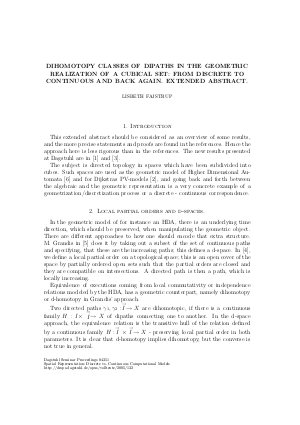Dihomotopy Classes of Dipaths in the Geometric Realization of a Cubical Set: from Discrete to Continuous and back again
Author Lisbeth Fajstrup
-
Part of:
Volume:
Dagstuhl Seminar Proceedings, Volume 4351
Part of: Series: Dagstuhl Seminar Proceedings (DagSemProc) - License:
 Creative Commons Attribution 4.0 International license
Creative Commons Attribution 4.0 International license
- Publication Date: 2005-04-22
File

PDF
DagSemProc.04351.13.pdf
- Filesize: 79 kB
- 3 pages
Document Identifiers
Subject Classification
Keywords
- Cubical Complex
- Higher Dimensional Automaton
- Ditopology
Metrics
- Access Statistics
-
Total Accesses (updated on a weekly basis)
0Document
0Metadata
Abstract
The geometric models of concurrency - Dijkstra's PV-models and V. Pratt's Higher Dimensional Automata - rely on a translation of discrete or algebraic information to geometry. In both these cases, the translation is the geometric realisation of a semi cubical complex, which is then a locally partially ordered space, an lpo space. The aim is to use the algebraic topology machinery, suitably adapted to the fact that there is a preferred time direction. Then the results - for instance dihomotopy classes of dipaths, which model the number of inequivalent computations should be used on the discrete model and give the corresponding discrete objects. We prove that this is in fact the case for the models considered: Each dipath is dihomottopic to a combinatorial dipath and if two combinatorial dipaths are dihomotopic, then they are combinatorially equivalent. Moreover, the notions of dihomotopy (LF., E. Goubault, M. Raussen) and d-homotopy (M. Grandis) are proven to be equivalent for these models - hence the Van Kampen theorem is available for dihomotopy. Finally we give an idea of how many spaces have a local po-structure given by cubes. The answer is, that any cubicalized space has such a structure after at most one subdivision. In particular, all triangulable spaces have a cubical local po-structure.
Cite As Get BibTex
Lisbeth Fajstrup. Dihomotopy Classes of Dipaths in the Geometric Realization of a Cubical Set: from Discrete to Continuous and back again. In Spatial Representation: Discrete vs. Continuous Computational Models. Dagstuhl Seminar Proceedings, Volume 4351, pp. 1-3, Schloss Dagstuhl – Leibniz-Zentrum für Informatik (2005)
https://doi.org/10.4230/DagSemProc.04351.13
BibTex
@InProceedings{fajstrup:DagSemProc.04351.13,
author = {Fajstrup, Lisbeth},
title = {{Dihomotopy Classes of Dipaths in the Geometric Realization of a Cubical Set: from Discrete to Continuous and back again}},
booktitle = {Spatial Representation: Discrete vs. Continuous Computational Models},
pages = {1--3},
series = {Dagstuhl Seminar Proceedings (DagSemProc)},
ISSN = {1862-4405},
year = {2005},
volume = {4351},
editor = {Ralph Kopperman and Michael B. Smyth and Dieter Spreen and Julian Webster},
publisher = {Schloss Dagstuhl -- Leibniz-Zentrum f{\"u}r Informatik},
address = {Dagstuhl, Germany},
URL = {https://drops.dagstuhl.de/entities/document/10.4230/DagSemProc.04351.13},
URN = {urn:nbn:de:0030-drops-1328},
doi = {10.4230/DagSemProc.04351.13},
annote = {Keywords: Cubical Complex , Higher Dimensional Automaton , Ditopology}
}
